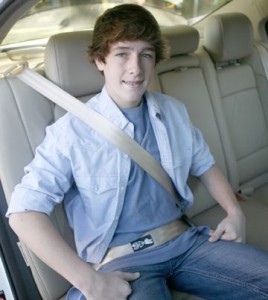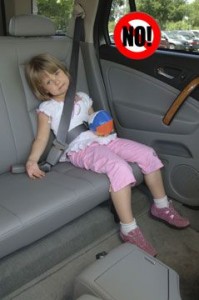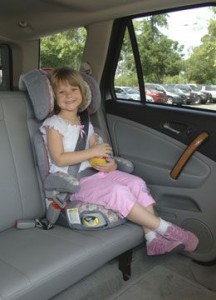How do seat belts and car seats work?
Seat belts and car seats are very effective at preventing deaths and reducing injuries when used and used correctly. But they can’t do their job unless they are used correctly. People who are not buckled up at all are much more likely to be ejected from the vehicle. People who are thrown out a window or door skid along the pavement and may be pinned or crushed under a vehicle.
Even if they aren’t ejected, unrestrained people are a danger to both themselves and others in the car. In a crash anything that is not restrained, including people, will fly around the vehicle. Unrestrained people can and do seriously injure or even kill other occupants in a crash.
How are seat belts and car seats designed to protect us?
Seat belts, booster seats, and car seats are designed to reduce injury to occupants and help to do so five different ways.
- Prevent ejection – People thrown from a vehicle are four times more likely to be killed than those who remain inside. Ejected occupants are also 14 times as likely to sustain cervical spine injury than those who remain within the vehicle.
- Load crash forces on the strongest parts of the body – For older children or adults, these parts are the hips and shoulders. For rear-facing infants and young children, this is the child’s back.
- Spread crash forces over a wide area of the body – This puts less stress on any one part of the body. Lap and shoulder seat belts and forward-facing car seat harnesses spread the crash forces across a large area of the body including the shoulder, chest, and hips. Rear-facing car seats spread the forces along the child’s entire back, neck and head.
- Allow the body to slow down gradually – Vehicles are engineered to crush in a controlled manner. Occupants can take advantage of the vehicle “ride down” only if they become a part of the vehicle by using a snug seat belt or properly installed car seat.
- Protect the head, neck, and spinal column – Shoulder belts and car seat harnesses help to keep the head and upper body away from the hard interior surfaces of the vehicle. Rear facing car seats support the head and neck to avoid stress on the neck and trauma to the head and spinal cord.
Importance of Correct Fit
The importance of a correct seat belt and car seat fit is often overlooked. However, a seat belt or car seat cannot provide maximum protection if it is not used correctly.
The main principles of correct seat belt fit are that:
- The shoulder belt should cross the shoulder between the neck and arm. The shoulder belt should never be tucked under an arm or behind the back because in this position the shoulder belt won’t be able to restrain the upper body in a crash.
- The lap belt must be as low as possible and at least touching the thighs so that crash forces are loaded onto the strong hip bones and not the soft abdominal area.
- Both the lap and shoulder belt should fit snugly across the body without any slack. If the lap belt is too loose, the occupant can slide under the lap belt in a process called “submarining.”
Proper Seat Belt Position
Photo Credit: NHTSA
Booster seats raise children up for a correct seat belt fit as described above and should be used until the child is large enough to fit correctly without the added “boost.”
Left: This child is too small to use the seat belt alone.
Right: The booster seat positions the child so that the seat belt fits properly.
Photo Credit: NHTSA
There is a common pattern of injuries that results when the lap belt is not worn in the proper position. Emergency room doctors commonly refer to this pattern of injuries as “seat belt syndrome.” Seat Belt syndrome occurs when the lap belt is worn across the stomach area instead of the hips. When a crash occurs the seat belt presses into the stomach causing injuries to the lower spine and organs such as the spleen, liver, and intestines.
Proper fit is also important for children riding in car seats. Proper use of car seats and recommendations for best protection are discussed in detail here.
Unsurvivable Crashes
Some crashes are so violent that even properly restrained occupants are seriously injured or killed. Factors such as the size, weight, speed and direction of the vehicles involved in the impact will affect the outcome. If the occupant compartment is crushed, restraints may be unable to prevent injury or death. However, probabilities and statistics cannot predict what will happen in every crash. A variety of factors determine injury outcome. Seat belts and car seats are designed to protect against the type of crash forces most likely to occur. The best way to avoid or reduce injury is to restrain the body in the most effective way possible.






